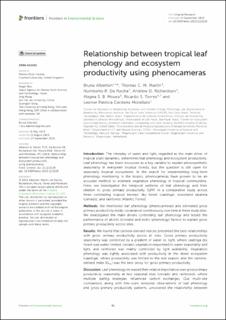| dc.contributor.author | Alberton, Bruna | |
| dc.contributor.author | Martin, Thomas C. M. | |
| dc.contributor.author | Da Rocha, Humberto R. | |
| dc.contributor.author | Richardson, Andrew D. | |
| dc.contributor.author | Moura, Magna S. B. | |
| dc.contributor.author | Da Silva Torres, Ricardo | |
| dc.contributor.author | Morellato, Leonor Patricia Cerdeira | |
| dc.date.accessioned | 2024-01-19T08:56:59Z | |
| dc.date.available | 2024-01-19T08:56:59Z | |
| dc.date.created | 2023-10-19T10:54:32Z | |
| dc.date.issued | 2023 | |
| dc.identifier.citation | Frontiers in Environmental Science. 2023, 11 . | en_US |
| dc.identifier.issn | 2296-665X | |
| dc.identifier.uri | https://hdl.handle.net/11250/3112696 | |
| dc.description.abstract | Introduction: The interplay of water and light, regarded as the main driver of tropical plant dynamics, determines leaf phenology and ecosystem productivity. Leaf phenology has been discussed as a key variable to explain photosynthetic seasonality in evergreen tropical forests, but the question is still open for seasonally tropical ecosystems. In the search for implementing long-term phenology monitoring in the tropics, phenocameras have proven to be an accurate method to estimate vegetative phenology in tropical communities. Here, we investigated the temporal patterns of leaf phenology and their relation to gross primary productivity (GPP) in a comparative study across three contrasting tropical biomes: dry forest (caatinga), woodland savanna (cerrado), and rainforest (Atlantic Forest).
Methods: We monitored leaf phenology (phenocameras) and estimated gross primary productivity (eddy-covariance) continuously over time at three study sites. We investigated the main drivers controlling leaf phenology and tested the performance of abiotic (climate) and biotic (phenology) factors to explain gross primary productivity across sites.
Results: We found that camera-derived indices presented the best relationships with gross primary productivity across all sites. Gross primary productivity seasonality was controlled by a gradient of water vs. light, where caatinga dry forest was water-limited, cerrado vegetation responded to water seasonality and light, and rainforest was mainly controlled by light availability. Vegetation phenology was tightly associated with productivity in the driest ecosystem (caatinga), where productivity was limited to the wet season, and the camera-derived index (Gcc) was the best proxy for gross primary productivity.
Discussion: Leaf phenology increased their relative importance over gross primary productivity seasonality at less seasonal sites (cerrado and rainforest), where multiple leafing strategies influenced carbon exchanges. Our multi-site comparison, along with fine-scale temporal observations of leaf phenology and gross primary productivity patterns, uncovered the relationship between leafing and productivity across tropical ecosystems under distinct water constraints. | en_US |
| dc.language.iso | eng | en_US |
| dc.publisher | Frontiers Media | en_US |
| dc.rights | Navngivelse 4.0 Internasjonal | * |
| dc.rights.uri | http://creativecommons.org/licenses/by/4.0/deed.no | * |
| dc.title | Relationship between tropical leaf phenology and ecosystem productivity using phenocameras | en_US |
| dc.title.alternative | Relationship between tropical leaf phenology and ecosystem productivity using phenocameras | en_US |
| dc.type | Peer reviewed | en_US |
| dc.type | Journal article | en_US |
| dc.description.version | publishedVersion | en_US |
| dc.source.pagenumber | 0 | en_US |
| dc.source.volume | 11 | en_US |
| dc.source.journal | Frontiers in Environmental Science | en_US |
| dc.identifier.doi | 10.3389/fenvs.2023.1223219 | |
| dc.identifier.cristin | 2186252 | |
| cristin.ispublished | true | |
| cristin.fulltext | original | |
| cristin.qualitycode | 1 | |

